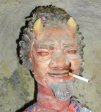 Writings By Location
Writings By Location| Toxic Chemical Roulette: The Mines of Potosí | 1 | 2 | 3 | 4 |
Juan told us a bit about himself, too, which was a slightly happier story. Juan, now about 30, started working in the mines after he finished high school. His father was a miner all his life, and is surprisingly still alive in his late 50s or early 60s, so it was, again, "the thing to do". His knowledge of about 25 words of English helped him to become a commonly sought-after attraction by the groups of tourists led by Koala Tours (the company we were with today). He did this for about three years, after which he had an accident that incapacitated him for several months. When he was healthy again, his wife basically forbade him to return (good for her), so he looked around for better work, and basically ended up with the tour agency. He makes less than he did as a miner, and he's still breathing in the toxic fumes of the mines every time he conducts a tour, but he'll most likely live to be a lot older.
Juan states that there is no way his children will work in the mines. Good thinking.
 |
| El Tio |
So, after all that lengthy background material, we turned our headlamps on and entered Candelaria Mine. We began by walking along the cart rails in the reasonably sized passage, having to duck down only a few times before we reached the "museum". Whether it can really be called a museum may be debatable, but it served the same purpose. Clambering through an unlocked door reveals a room containing tributes to the mining industry in Bolivia. Included were cheesy, generic wax figures illustrating the impacts of the European slave trade, the piracy of Sir Francis Drake, and the miners' fascination with and worship of "El Tio", their depiction of the devil. (Although devoutly Catholic, the miners make offerings to the devil when underground, believing it is squarely his turf. Sculptures and statuettes of "El Tio" grace the various mine passages, usually showing him with a bottle of alcohol, a cigarette, and an enormous schlong. I'm assuming that doesn't get used or anything.)
 |
| At Work in the Mines |
After leaving the museum, we continued through the tight, narrow passageways, spending most of the time walking while hunched over and with our legs half-bent. The smell of arsenic fumes began to permeate the air, and that, combined with our posture, made it harder and harder to breathe. With our bandanas in place over our faces, we descended further, and soon stopped to examine some veins of zinc and arsenic that were visible. Nearby, we heard two miners quietly working on digging a hole to extract more rocks. We clambered up to talk with them, and watched as one of them placed a long iron rod into a hole, and hammered it into the rock with a chisel. All by hand. Eventually, in four hours they estimated, they would get the rod about 20-22 cm in, then rest for a while and go somewhere else to work, until 5pm that night, when they'd shove dynamite into the hole to extract another 80-100 kg worth of rock infused with zinc.